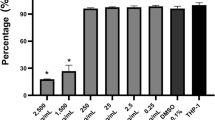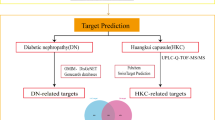Abstract
Aim:
To characterize a small molecule compound HK-156 as a novel inhibitor of the nuclear factor κB (NF-κB) signaling pathway.
Methods:
THP-1 monocytes and HEK293/hTLR4A-MD2-CD14 cells were tested. HK-156 and compound 809, an HK-156 analogue, were synthesized. A luciferase assay was used to evaluate the transcriptional activity of NF-κB. The levels of cytokines were measured with cytokine arrays, ELISA and quantitative PCR. An electrophoretic mobility shift assay (EMSA), immunofluorescence, Western blot and mass spectrometry were used to investigate the molecular mechanisms underlying the actions of the agent. BALB/c mice challenged with lipopolysaccharide (LPS, 15 mg/kg, ip) were used as a mouse experimental endotoxemia model.
Results:
In HEK293hTLR4/NF-κB-luc cells treated with LPS (1000 ng/mL), HK-156 inhibited the transcriptional activity of NF-κB in a concentration-dependent manner (IC50=6.54±0.37 μmol/L). Pretreatment of THP-1 monocytes with HK-156 (5, 10 and 20 μmol/L) significantly inhibited LPS-induced release and production of TNF-α and IL-1β, attenuated LPS-induced translocation of NF-κB into the nucleus and its binding to DNA, and suppressed LPS-induced phosphorylation and degradation of IκBα, and phosphorylation of IKKβ and TGFβ-activated kinase (TAK1). Meanwhile, HK-156 (5, 10 and 20 μmol/L) slightly suppressed LPS-induced activation of p38. The effect of HK-156 on LPS-induced activation of NF-κB signaling was dependent on thiol groups of cysteines in upstream proteins. In mouse models of sepsis, pre-injection of HK-156 (50 mg/kg, iv) significantly inhibited TNFα production and reduced the mortality caused by the lethal dose of LPS.
Conclusion:
HK-156 inhibits LPS-induced activation of NF-κB signaling by suppressing the phosphorylation of TAK1 in vitro, and exerts beneficial effects in a mouse sepsis model. HK-156 may therefore be a useful therapeutic agent for treating sepsis.
Similar content being viewed by others
Log in or create a free account to read this content
Gain free access to this article, as well as selected content from this journal and more on nature.com
or
References
Hayden MS, Ghosh S . Shared principles in NF-kappaB signaling. Cell 2008; 132: 344–62.
Vallabhapurapu S, Karin M . Regulation and function of NF-kappaB transcription factors in the immune system. Annu Rev Immunol 2009; 27: 693–733.
Huxford T, Ghosh G . A structural guide to proteins of the NF-kappaB signaling module. Cold Spring Harb Perspect Biol 2009; 1: a000075.
Pahl HL . Activators and target genes of Rel/NF-kappaB transcription factors. Oncogene 1999; 18: 6853–66.
Yamamoto Y, Gaynor RB . Role of the NF-kappaB pathway in the pathogenesis of human disease states. Curr Mol Med 2001; 1: 287–96.
Gerondakis S, Grumont R, Gugasyan R, Wong L, Isomura I, Ho W, et al. Unravelling the complexities of the NF-kappaB signalling pathway using mouse knockout and transgenic models. Oncogene 2006; 25: 6781–99.
Dong J, Jimi E, Zeiss C, Hayden MS, Ghosh S . Constitutively active NF-kappaB triggers systemic TNFalpha-dependent inflammation and localized TNFalpha-independent inflammatory disease. Genes Dev 2010; 24: 1709–17.
Ivanenkov YA, Balakin KV, Tkachenko SE . New approaches to the treatment of inflammatory disease: focus on small-molecule inhibitors of signal transduction pathways. Drugs R D 2008; 9: 397–434.
O'Neill LA . Targeting signal transduction as a strategy to treat inflammatory diseases. Nat Rev Drug Discov 2006; 5: 549–63.
Sarkar FH, Li Y, Wang Z, Kong D . NF-kappaB signaling pathway and its therapeutic implications in human diseases. Int Rev Immunol 2008; 27: 293–319.
Suffredini AF, Munford RS . Novel therapies for septic shock over the past 4 decades. JAMA 2011; 306: 194–9.
Bone RC, Grodzin CJ, Balk RA . Sepsis: a new hypothesis for pathogenesis of the disease process. Chest 1997; 112: 235–43.
Munford RS . Severe sepsis and septic shock: the role of gram-negative bacteremia. Annu Rev Pathol 2006; 1: 467–96.
Liu SF, Malik AB . NF-kappa B activation as a pathological mechanism of septic shock and inflammation. Am J Physiol Lung Cell Mol Physiol 2006; 290: L622–45.
Lu YC, Yeh WC, Ohashi PS . LPS/TLR4 signal transduction pathway. Cytokine 2008; 42: 145–51.
Sato S, Sanjo H, Takeda K, Ninomiya-Tsuji J, Yamamoto M, Kawai T, et al. Essential function for the kinase TAK1 in innate and adaptive immune responses. Nat Immunol 2005; 6: 1087–95.
Guha M, Mackman N . LPS induction of gene expression in human monocytes. Cell Signal 2001; 13: 85–94.
Kawai T, Akira S . The role of pattern-recognition receptors in innate immunity: update on Toll-like receptors. Nat Immunol 2010; 11: 373–84.
Miggin SM, O'Neill LA . New insights into the regulation of TLR signaling. J Leukoc Biol 2006; 80: 220–6.
Beutler B . Microbe sensing, positive feedback loops, and the pathogenesis of inflammatory diseases. Immunol Rev 2009; 227: 248–63.
Wheeler DS, Zingarelli B, Wheeler WJ, Wong HR . Novel pharmacologic approaches to the management of sepsis: targeting the host inflammatory response. Recent Pat Inflamm Allergy Drug Discov 2009; 3: 96–112.
Gilmore TD, Herscovitch M . Inhibitors of NF-kappaB signaling: 785 and counting. Oncogene 2006; 25: 6887–99.
Calzado MA, Bacher S, Schmitz ML . NF-kappaB inhibitors for the treatment of inflammatory diseases and cancer. Curr Med Chem 2007; 14: 367–76.
Bamborough P, Callahan JF, Christopher JA, Kerns JK, Liddle J, Miller DD, et al. Progress towards the development of anti-inflammatory inhibitors of IKKbeta. Curr Top Med Chem 2009; 9: 623–39.
Leon CG, Tory R, Jia J, Sivak O, Wasan KM . Discovery and development of toll-like receptor 4 (TLR4) antagonists: a new paradigm for treating sepsis and other diseases. Pharm Res 2008; 25: 1751–61.
Barochia A, Solomon S, Cui X, Natanson C, Eichacker PQ . Eritoran tetrasodium (E5564) treatment for sepsis: review of preclinical and clinical studies. Expert Opin Drug Metab Toxicol 2011; 7: 479–94.
Abraham E . Nuclear factor-kappaB and its role in sepsis-associated organ failure. J Infect Dis 2003; 187: S364–9.
Robbins CS, Swirski FK . The multiple roles of monocyte subsets in steady state and inflammation. Cell Mol Life Sci 2010; 67: 2685–93.
Suzuki T, Hashimoto S, Toyoda N, Nagai S, Yamazaki N, Dong HY, et al. Comprehensive gene expression profile of LPS-stimulated human monocytes by SAGE. Blood 2000; 96: 2584–91.
Palsson-McDermott EM, O'Neill LA . Signal transduction by the lipopolysaccharide receptor, Toll-like receptor-4. Immunology 2004; 113: 153–62.
Landstrom M . The TAK1-TRAF6 signalling pathway. Int J Biochem Cell Biol 2010; 42: 585–9.
Hayden MS, Ghosh S . Signaling to NF-kappaB. Genes Dev 2004; 18: 2195–224.
Guha M, O'Connell MA, Pawlinski R, Hollis A, McGovern P, Yan SF, et al. Lipopolysaccharide activation of the MEK-ERK1/2 pathway in human monocytic cells mediates tissue factor and tumor necrosis factor alpha expression by inducing Elk-1 phosphorylation and Egr-1 expression. Blood 2001; 98: 1429–39.
Tracey KJ, Cerami A . Tumor necrosis factor, other cytokines and disease. Annu Rev Cell Biol 1993; 9: 317–43.
Secher T, Vasseur V, Poisson DM, Mitchell JA, Cunha FQ, Alves-Filho JC, et al. Crucial role of TNF receptors 1 and 2 in the control of polymicrobial sepsis. J Immunol 2009; 182: 7855–64.
Huang W, Tang Y, Li L . HMGB1, a potent proinflammatory cytokine in sepsis. Cytokine 2010; 51: 119–26.
Wang H, Bloom O, Zhang M, Vishnubhakat JM, Ombrellino M, Che J, et al. HMG-1 as a late mediator of endotoxin lethality in mice. Science 1999; 285: 248–51.
Delhase M, Hayakawa M, Chen Y, Karin M . Positive and negative regulation of IkappaB kinase activity through IKKbeta subunit phosphorylation. Science 1999; 284: 309–13.
Yang F, Tang E, Guan K, Wang CY . IKK beta plays an essential role in the phosphorylation of RelA/p65 on serine 536 induced by lipopolysaccharide. J Immunol 2003; 170: 5630–5.
Anest V, Hanson JL, Cogswell PC, Steinbrecher KA, Strahl BD, Baldwin AS . A nucleosomal function for IkappaB kinase-alpha in NF-kappaB-dependent gene expression. Nature 2003; 423: 659–63.
Yamamoto Y, Verma UN, Prajapati S, Kwak YT, Gaynor RB . Histone H3 phosphorylation by IKK-alpha is critical for cytokine-induced gene expression. Nature 2003; 423: 655–9.
Lawrence T, Bebien M, Liu GY, Nizet V, Karin M . IKKalpha limits macrophage NF-kappaB activation and contributes to the resolution of inflammation. Nature 2005; 434: 1138–43.
Liu B, Yang Y, Chernishof V, Loo RR, Jang H, Tahk S, et al. Proinflammatory stimuli induce IKKalpha-mediated phosphorylation of PIAS1 to restrict inflammation and immunity. Cell 2007; 129: 903–14.
Liu B, Shuai K . Targeting the PIAS1 SUMO ligase pathway to control inflammation. Trends Pharmacol Sci 2008; 29: 505–9.
Ling L, Cao Z, Goeddel DV . NF-kappaB-inducing kinase activates IKK-alpha by phosphorylation of Ser-176. Proc Natl Acad Sci U S A 1998; 95: 3792–7.
Wang RP, Zhang M, Li Y, Diao FC, Chen D, Zhai Z, et al. Differential regulation of IKK alpha-mediated activation of IRF3/7 by NIK. Mol Immunol 2008; 45: 1926–34.
Leung CH, Grill SP, Lam W, Gao W, Sun HD, Cheng YC . Eriocalyxin B inhibits nuclear factor-kappaB activation by interfering with the binding of both p65 and p50 to the response element in a noncompetitive manner. Mol Pharmacol 2006; 70: 1946–55.
Leung CH, Grill SP, Lam W, Han QB, Sun HD, Cheng YC . Novel mechanism of inhibition of nuclear factor-kappa B DNA-binding activity by diterpenoids isolated from Isodon rubescens. Mol Pharmacol 2005; 68: 286–97.
Lee Y, Shin DH, Kim JH, Hong S, Choi D, Kim YJ, et al. Caffeic acid phenethyl ester-mediated Nrf2 activation and IkappaB kinase inhibition are involved in NFkappaB inhibitory effect: structural analysis for NFkappaB inhibition. Eur J Pharmacol 2010; 643: 21–8.
Rossi A, Kapahi P, Natoli G, Takahashi T, Chen Y, Karin M, et al. Anti-inflammatory cyclopentenone prostaglandins are direct inhibitors of IkappaB kinase. Nature 2000; 403: 103–8.
Acknowledgements
The work was funded by State key Laboratory of Drug Research. We wish to express our sincere thanks to Ms Yuan ZHOU (Novartis Institutes for BioMedical Research, Shanghai, China) for her technical assistance. We also thank Xin-yan NI for animal studies.
Author information
Authors and Affiliations
Corresponding authors
Additional information
Supplementary figures are available at website of Acta Pharmacologica Sinica on NPG.
Supplementary information
Supplementary data, Figure 1
Synthetic route to the compound HK-156 and 809 (DOC 162 kb)
Rights and permissions
About this article
Cite this article
Fang, Jp., Liu, Y., Li, J. et al. A novel small molecule, HK-156, inhibits lipopolysaccharide-induced activation of NF-κB signaling and improves survival in mouse models of sepsis. Acta Pharmacol Sin 33, 1204–1216 (2012). https://doi.org/10.1038/aps.2012.56
Received:
Accepted:
Published:
Issue date:
DOI: https://doi.org/10.1038/aps.2012.56
Keywords
This article is cited by
-
Honokiol Attenuates Sepsis-Associated Acute Kidney Injury via the Inhibition of Oxidative Stress and Inflammation
Inflammation (2019)
-
Mesenchymal stem cells attenuate sepsis-induced liver injury via inhibiting M1 polarization of Kupffer cells
Molecular and Cellular Biochemistry (2019)
-
Effects of Honokiol on Sepsis-Induced Acute Kidney Injury in an Experimental Model of Sepsis in Rats
Inflammation (2014)
-
Celebrating the 80th anniversary of the Shanghai Institute of Materia Medica, Chinese Academy of Sciences (SIMM)
Acta Pharmacologica Sinica (2012)



